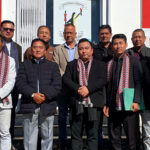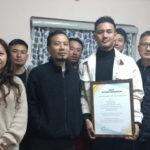Insights into challenges and opportunities facing scientific research in Nagaland
A new species of glyptosternine catfish, Exostoma sentiyonoae, has been discovered in the Dzuleke River, a tributary of the Barak River in Nagaland. This finding was detailed in the scientific journal Zootaxa (Vol. 5447).
The species was identified by Dr Limatemjen, Professor and Dean of Sciences at Kohima Science College Autonomous, along with Bungdon Shangningam, a scientist from the Zoological Survey of India in Kolkata, who works with the Ministry of Environment, Forest and Climate Change.

Talking to MT, Dr Limatemjen said he named the species in honor of his daughter, combining “Senti” from the Ao Naga language and “Yono” from the Angami Naga language.
Speaking on the significance of the discovery, he stated, “In Nagaland, there are many things yet to be discovered. Our state falls under a region of hot biodiversity, and there is much we have yet to explore. We often overlook this, and only through thorough research can we confirm a new species.”
Expressing concern over the complacency on research, Dr Limatemjen said he feels his discovery is significant as many people don’t know what is happening in the state.
“Discovery means reporting for the first time. So, it will be very significant because many people don’t know what is happening in our state. We are only concerned about what is happening outside the state and we give much importance to people working outside whereas, the few workers in our state are often sidelined,” he shared, adding that perhaps, the social media should also focus on the people working in Nagaland thereby encouraging the researchers.
Dr Limatemjen, who has a keen interest in taxonomy, is dedicated to his research work, and has even opted out of a principal post. “I wanted to see Nagas come up with this mindset of doing the research work, like these donkeys. I call them donkeys because donkeys are hard working,” he said, adding a touch of humor.
Dr Limatemjen currently supervises five research scholars: three are studying fish in various drainage systems, one is researching freshwater plankton, and another is focusing on terrestrial snails, a first for Nagaland. “I have diversified my taxonomy projects,” he explained.
Dr Limatemjen’s previous work also includes significant discoveries such as: Chordodes combiaerolatus, a new species of horsehair worm (Zootaxa 3925, 2015), the Gondwana genus Beatogordius from India (ZooKeys 643, 2017), New records of horsehair worms from India (Taxonomy 2020), Platylomia kohimanensis, a new cicada species from the Naga Hills (Zootaxa 5047, 2021), and the threatened catfish Pterocryptis barakensis from Nagaland (National Journal of Life Sciences, 2023) among many others.
Dr Limatemjen also encouraged local researchers to pursue studies within the state. “While people from outside come to conduct research here, we must do more research ourselves. The media should promote the importance of this work. It is disheartening when a discovery from our state has an author from elsewhere,” he noted.
Regarding his long-term goals, Dr Limatemjen expressed a desire to continue his research as long as possible, though he is uncertain about its future. “I am interested in general taxonomy and have collaborated with researchers from Germany and India. I believe that before we think about exploring the moon or space, it’s crucial to understand what exists in our own state,” he said.
Dr Limatemjen noted that Nagaland is a biodiversity hotspot with immense research potential. However, he lamented that rather than exploring this potential, it is being destroyed before significant discoveries can be made. “We should do extensive work on biodiversity, including both plants and animals,” he urged, emphasizing that research can elevate the state’s profile and allow students to gain global recognition.
Dr Limatemjen outlined several challenges researchers face, particularly in communication. “We often have to walk for hours for research work and exploration. Secondly, there are so many restrictions imposed by various communities and this kind of blanket restriction is not good for researchers. Sometimes, we have to use certain gears, certain methodology to collect the sample. Until we have the sample in our hand, how can we do research work? So, certain issues have to be addressed for the genuine research workers,” he explained.
“The research facilities we have… are minimal. We still need many more instruments and are in a delimma about how to obtain them.”
Dr Limatemjen stressed the importance of ethical sampling practices, stating, “We make it a point not to collect more than what is necessary. For instance, if we require five samples, we only collect five. We have to seek permission for many activities. For example, to collect samples from a river, we focus on variety rather than quantity. We employ techniques for selective harvesting, ensuring that the gadgets we use for selective fishing are safe.”
He also noted that a lack of connection with the rest of the world poses difficulties, often disrupting their work due to limited exposure.res
Dr Limatemjen highlighted the importance of conservation, stating, “Water is a basic requirement. If we learn to conserve the fauna of the river, we are directly conserving the water bodies. It is not about conserving a single species. By conservation, I mean the spawning grounds where the fish spawn. These areas need to be protected.”
He further explained, “The riparian corridor is essential for the health of the river. It filters the water entering the river, stopping debris. The canopy supports insects and other organisms that serve as food for fish, contributing to the nutrient cycling in the water bodies.”
When asked about the state’s ambition to become self-reliant in fish production by 2030, he expressed hope that the department would achieve this but suggested that policymakers should connect with researchers to realize these goals. “Policies are made at the table, but we researchers go into the field. We know the ground reality, so if policymakers can engage with those working on the ground, we can improve outcomes,” he added.
ALSO READ: New species of catfish discovered in Dzuleke River, Nagaland
On the role of the state government in funding research, he stated, “The research facilities we have, even in my lab, are minimal. I am collaborating with a German organization, GIZ, which funded the purchase of a stereo zoom microscope costing Rs 6.5 lakhs, significantly contributing to our research. However, we still need many more instruments and are in a dilemma about how to obtain them. We hope the government will realize the need for more funding.”
He pointed out that five departments at Kohima Science College Autonomous are actively engaged in research, with around 20 scholars currently involved. “This research program is now one of the most important components of our college. If we can conduct substantial research work, we can attract talent from other parts of the world,” he said.
Dr Limatemjen further discussed the shortage of human resources in the state. “We lack sufficient human resources, which is why we have been asking people from outside the state to assist with high-tech work or any tasks involving technology. Human resources will only be generated through research. I am committed to conducting research work to create human resources for the betterment of our society. Likewise, if other labs can generate human resources, perhaps we will one day be self-sufficient,” he said.
In discussing Kohima Science College, he expressed pride in the collaborative spirit among faculty and students, saying, “We work with a positive attitude.”



